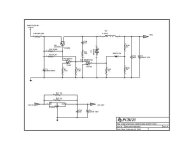Kingfish
100 MW
Love the support guys! OK, let me get to it!
Quick Status:
Policy:
It should be said that no idea is too silly to be entertained, and in the Professional World this is pretty much the modus operandi. That assumed - governance is required to stay on top. My role is both as taskmaster and arbitrator: Build a consensus – but don’t take too long, keep our Ship of Development floating forward through the rocky straights and gale winds whilst preventing mutiny over the bounty of knowledge and option.
Schedule:
I’m in a hurry, and in fact my plans for my next ebike are arrested until we resolve fundamental issues that I believe we all share. Right now we are talking about the Controller: It’s features and functions, and divvying it up into three parts. We are taking suggestions and the door is wide open to contribution until we can sort ourselves out, dust off the furniture, confirm our marching orders, and set the ledger straight.
Today is Wednesday, August 18. I will re-present the Feature Specification as a Request before EOD (presuming this is ok…) in the Technical Reference area. The Request will be updated once each morning for one week, and that should afford enough time to capture the majority opinion.
Keep posting your thoughts and ideas to this thread!
About Noon (PST) Wednesday, August 25 – the Feature Request will close for Version 1. Then the weeding begins. Stakeholders and Contributors should identify themselves so that we can build teams.
Sobering before the Hillclimb:
I have managed a wide range of individuals from the broad walk of life, inducing and honing their focus to produce several challenging events every year as a Not-For-Profit. There will be petty grievances and prima donnas: Keep your cool, breath frequently, relax, we’re all pals, let’s play nice!
Anyone ever involved in public planning on a large scale understands that it is a lot like cat-herding :? :lol:
:? :lol:
Right. Let’s get started…
Quick Status:
- Waiting for buyoff on major forum stakeholders for how to manage docs: I think we have a plan in place.
- In the meantime I have been fleshing out hi- and low-details, and creating a list of important questions to ask.
- I am very conscious of keeping the “Fun†in this project: Having Fun is very important for a lot of reasons as it keeps the enthusiasm and attention focused on the topic with the added benefit of little delights as we progress. If it ain’t fun it ain’t worth doing, Grrr! :wink:
Policy:
It should be said that no idea is too silly to be entertained, and in the Professional World this is pretty much the modus operandi. That assumed - governance is required to stay on top. My role is both as taskmaster and arbitrator: Build a consensus – but don’t take too long, keep our Ship of Development floating forward through the rocky straights and gale winds whilst preventing mutiny over the bounty of knowledge and option.
Schedule:
I’m in a hurry, and in fact my plans for my next ebike are arrested until we resolve fundamental issues that I believe we all share. Right now we are talking about the Controller: It’s features and functions, and divvying it up into three parts. We are taking suggestions and the door is wide open to contribution until we can sort ourselves out, dust off the furniture, confirm our marching orders, and set the ledger straight.
Today is Wednesday, August 18. I will re-present the Feature Specification as a Request before EOD (presuming this is ok…) in the Technical Reference area. The Request will be updated once each morning for one week, and that should afford enough time to capture the majority opinion.
Keep posting your thoughts and ideas to this thread!
About Noon (PST) Wednesday, August 25 – the Feature Request will close for Version 1. Then the weeding begins. Stakeholders and Contributors should identify themselves so that we can build teams.
Sobering before the Hillclimb:
I have managed a wide range of individuals from the broad walk of life, inducing and honing their focus to produce several challenging events every year as a Not-For-Profit. There will be petty grievances and prima donnas: Keep your cool, breath frequently, relax, we’re all pals, let’s play nice!
Anyone ever involved in public planning on a large scale understands that it is a lot like cat-herding
Right. Let’s get started…




